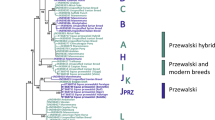Abstract
Reconstruction of the mitochondrial genome of a horse from the Ashna-Pando hillfort (the Sura River basin, Middle Volga, Ulyanovsk oblast, Russia) was performed using bone remains. It was established that, according to a fragment of the control region (D-loop), the specimen belongs to the B1 haplotype widespread among modern as well as ancient horses of Europe and Asia. However, in accordance with complete mitochondrial genome analysis, the horse is attributed to the M haplogroup that includes different modern breeds, with the Akhal-Teke breed among them. The obtained data make it possible to postulate the steppe origin of the horse. On the basis of our analysis, penetration of the southern horses deep into the broadleaf forest area likely dates to the second or third quarter of the first millennium BC and is probably connected with interactions of the sedentary population of the Sura River region with Scythian nomads.



Similar content being viewed by others
REFERENCES
Lippold, S., Matzke, N.J., Reissmann, M., and Hofreiter, M., Whole mitochondrial genome sequencing of domestic horses reveals incorporation of extensive wild horse diversity during domestication, BMC Evol. Biol., 2011, vol. 11, p. 328. https://doi.org/10.1186/1471-2148-11-328
Wallner, B., Vogl, C., Shukla, P., et al., Identification of genetic variation on the horse y chromosome and the tracing of male founder lineages in modern breeds, PLoS One, 2013, vol. 8. e60015. https://doi.org/10.1371/journal.pone.0060015
Bader, O.N. and Khalikov, A.Kh., Sites of the Balanovo Culture, in Svod Arkheologicheskikh Istochnikov (Corpus of Archaeological Sources), Moscow: Nauka, 1976.
Stepanov, P.D., Osh-Pando, Saransk: Mordovskoe Knizhnoe Izd., 1967.
Sarapulkina, T.V., Economic and cultural type of urban population of the Upper Don, Izv. Samar. Nauchn. Ts. Russ. Akad. Nauk, 2010, vol. 12, no. 2, pp. 278—281.
Karavaiko, D.V. and Gorbanenko, S.A., Gospodarstvo nosiïv yukhnivs’koï kul’turi (The Economy of the Carriers of the Yukhnov Culture), Kiïv: Naukova Dumka, 2012.
Matveeva, G.I., Middle Volga region in the 4th—7th centuries AD, in Imen’kovskaya kul’tura (Imenkovskaya Culture), Samara: Samara Univ., 2004, pp. 74—76.
Druzhkova, A.S., Thalmann, O., Trifonov, V.A., et al., Ancient DNA analysis affirms the canid from Altai as a primitive dog, PLoS One, 2013, vol. 8, no. 3. e57754. https://doi.org/10.1371/journal.pone.0057754
Maricic, T., Whitten, M., and Pääbo, S., Multiplexed DNA sequence capture of mitochondrial genomes using PCR products, PLoS One, 2010, vol. 5, no. 11. e14004. https://doi.org/10.1371/journal.pone.0014004
Cieslak, M., Pruvost, M., Benecke, N., et al., Origin and history of mitochondrial DNA lineages in domestic horses, PLoS One, 2010, vol. 5, no. 12. e15311. https://doi.org/10.1371/journal.pone.0015311
Achilli, A., Olivieri, A., Soares, P., et al., Mitochondrial genomes from modern horses reveal the major haplogroups that underwent domestication, Proc. Natl. Acad. Sci. U.S.A., 2012, vol. 109, no. 7, pp. 2449—2454.
Kusliy, M.A., Druzhkova, A.S., Popova, K.O., et al., Genotyping and coat colour detection of ancient horses from Buryatia, Tsitologiya, 2016, vol. 58, pp. 304—308.
ACKNOWLEDGMENTS
We are grateful to A.S. Graphodatsky, N.V. Vorobieva, A.S. Druzhkova, M.A. Kusliy, and V.A. Trifonov (Institute of Molecular and Cellular Biology of the Siberian Branch of the Russian Academy of Sciences, Novosibirsk State University, Novosibirsk) for comprehensive assistance in conducting research and interpreting the obtained results.
Funding
This study was conducted with support of the Russian Foundation for Basic Research, grant no. 18-44-730006.
Author information
Authors and Affiliations
Corresponding author
Ethics declarations
The authors declare that they have no conflict of interest. This article does not contain any studies involving animals or human participants performed by any of the authors.
Additional information
Translated by I. Grishina
Rights and permissions
About this article
Cite this article
Antonova, E.I., Solovyev, A.V., Vyazov, L.A. et al. Reconstruction of the Mitochondrial Genome of the Ancient Horse from the Ashna-Pando Hillfort (Middle Volga). Russ J Genet 55, 598–603 (2019). https://doi.org/10.1134/S1022795419050041
Received:
Revised:
Accepted:
Published:
Issue Date:
DOI: https://doi.org/10.1134/S1022795419050041




